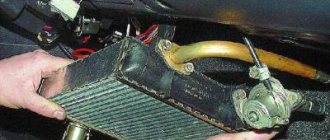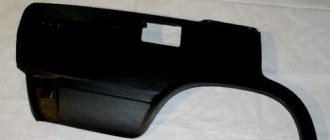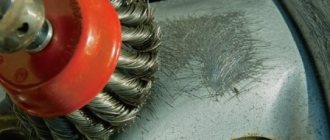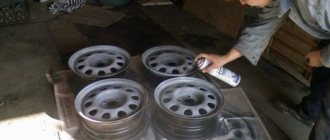And yet: is it necessary to close the car radiator in winter and the relevance of the “cardboard”
Theoretical effect
It is better to learn how to properly close the radiator for the winter from experienced drivers. There’s nothing complicated about it, but some extra advice won’t hurt. Be interested in what and how, preferably after mastering it, why it is needed and getting an answer to the question whether this method of insulation actually helps. Making a final decision is possible only if the needs of the owner and the guarantees of this method of thermal insulation coincide.
Restricting air access to the engine through the radiator grille in winter gives:
- Reducing the time it takes to fully warm up the engine during frequent short trips.
- Acceleration of coolant reaching operating temperature when warming up the power plant while driving.
- Preservation of heat in the engine compartment when driving on the highway.
Practical significance
Premium cars have long been equipped with a system of dampers that regulate the volume of air flowing over the engine. Ensuring that the power plant quickly reaches operating temperature and maintaining it within specifications helps preserve the factory life of internal combustion engine parts.
Natural thermal conditions in cold weather are only beneficial and here’s why:
- Reducing the warm-up time leads to a decrease in fuel consumption, since the ECU generates an over-rich mixture when it is cold.
- Reducing the proportion of air cooling at high speed allows the interior heater to operate at full capacity.
The help of insulation is especially noticeable at temperatures below -20°C: the computer displays suburban fuel consumption values close to summer values, and the stove heats up noticeably even at idle. This fact is confirmed by both owners of carburetor cars and owners of injectors. However, you can only get by with an additional homemade car interior heater designed for 12 Volts.
The position of companies specializing in the production of insulating components is clear. Often, when asked whether it is necessary to close the radiator in winter, they put forward additional arguments in favor:
- Fuel savings up to 25%.
- Eases cold starts.
- Increased battery life.
It is quite clear that the savings percentage is overestimated, and the closed radiator grill does not affect the morning start-up in any way - the engine managed to freeze overnight. There is also no gentle operation of the battery, since you still have to turn the crankshaft in thick oil.
Engine warming devices
Designed to quickly warm up the main unit of the car. Its main drawback is its dependence on a 220-volt household network, so it is increasingly being used in car enthusiasts’ garages.
In addition, such a system is not capable of starting automatically - only in manual mode. Complete heating of the coolant is achieved after 20-30 minutes.
Much depends on the type of device and manufacturer. Costs from 2,000 rubles and above. Installation of such systems does not cause difficulties even for novice car enthusiasts.
The main thing is to act strictly according to the instructions provided by the manufacturer.
Autonomous pre-heater.
One of the best options if you have an extra 15-20 thousand rubles or more on hand. The advantage of the system is complete autonomy.
It is enough to program the device, and it will turn on several times a night, warming up the engine.
Today there are many different modifications of such systems with many useful functions. But it is better to entrust their installation to experienced specialists.
Proper insulation or how to properly close the engine radiator for the winter: technologies and tips
The positive results from thermal insulation of the radiator grille are due to the fact that the engine consumes less resources to achieve and maintain operating temperature than with air cooling in winter. An additional effect is the protection of the heat exchanger honeycombs from the ingress of road reagents, which leads to an increase in corrosion resistance and preservation of the factory life of the part.
Requirements
Disrupting air cooling can cause harm. Untimely and hasty cover of the radiator grille leads to overheating of the engine. You can reduce the likelihood of thermal imbalance, and the following tips will help you do this:
- Do not lean the element directly against the radiator - there must be a gap between the heat exchanger and the thermal insulation.
- Install insulation at a temperature of -10°C or less.
- Do not cover the entire area of the heat exchange element.
For your information. The rules apply to both petrol and diesel versions.
A trivial method of insulation is to insert between the heat exchanger and the bumper a piece of cardboard cut from the box of some household product to certain dimensions. A heat exchange element covered 2/3 in this way is a simple solution to the problem of how to properly close a car radiator for the winter using improvised means.
Owners of cars equipped with air conditioning will benefit from another method of insulation: insert a newspaper between the condenser and the main heat exchanger. The total thickness of the sheets should be such that they move freely between the walls of the radiators.
The disadvantage of quick methods is that they ruin the aesthetics of the front of the vehicle and are not as effective in severe frosts. However, advanced ideas require costs, but the effect is better:
- A set of dampers designed for a specific vehicle.
- External masks for radiator grilles.
- Homemade imitation of branded shields.
Factory products
Model-specific plastic covers are attached invisibly. The shape of the damper closely follows the geometry of the radiator grille and does not cover the car manufacturer’s emblem. Synthetic masks, for example, from the Tammers company, hide the architecture of the decorative sieve, and external quick-release fasteners are not to everyone’s taste.
The price of such a solution will not suit everyone. A plastic shield will cost 500-700 rubles. An impact-resistant and waterproof mask made of synthetic fabric costs about 3,000 rubles.
Insulation yourself
The easiest option is to insert pieces of cardboard between the grille and the radiator. This allows you to slightly reduce heat loss when traveling in winter. But this is not very effective. Besides, it's not very aesthetically pleasing. Therefore, it is best to use more modern insulation methods. Please note that working with radiator insulation is not enough.
You should also pay attention to the entire engine and engine compartment. When installing, be sure to securely fasten the insulation correctly. If it accidentally gets under the generator or timing belts, you will have to make expensive repairs to these systems.
The importance of additional engine insulation
As can be seen in the photo of engine insulation, such an event means the installation of additional thermal insulation.
A nice bonus in some cases is improved sound insulation. There are also advantages:
- slower engine cooling and faster reaching operating temperature;
- increasing the level of comfort when using the machine in the winter months.
Peculiarities
Today on sale you can find special car blankets designed to insulate the engine compartment of a car.
Insulating the engine with your own hands using them is quite simple. Even a beginner can handle the procedure. If you don’t want to spend money, then you can use improvised means for this purpose.
The global market amazes with the range of thermal insulation for cars. Modern insulation can not only protect the engine, but also reduce fuel consumption.
But not all drivers are confident in the need for such work. Many consider them a waste of time and money.
In reality, it is up to you whether to carry out additional thermal insulation measures or not. In any case, you will have to make one of the following decisions:
- equip the car with autostart;
- use an engine preheater.
Thanks to such mechanisms, time is saved after a long period of inactivity in frosty weather - you get behind the wheel in a warmed-up interior.
But it is worth noting their rather high price. In addition, the automatic start system requires high fuel consumption, and the preheater will significantly reduce the durability of the battery.
Types of car blankets
Based on the material of manufacture, such products are:
- Felt. Advantage - low thermal conductivity, disadvantage - insufficient fire safety.
- Fiberglass. Advantages - financial accessibility, low heat conductivity.
- From mullite-siliceous materials. Pros: frost resistance, resistance to aggressive chemicals and temperature changes.
On the outside, the types of thermal insulation described above are covered with durable and strong non-flammable fabric that can withstand high temperatures.
The following option is also possible - the presence of a mirror film on car blankets designed to reflect heat.
Specifics of the engine insulation process
After you have decided how to insulate the VAZ engine, you need to install a car blanket. The event is simple. No knowledge or special effort is required from you.
Car insulation will pay for itself within 1 – 2 months. With its help, heat will be retained, allowing the engine to reach operating temperature.
In addition, blankets for cars are non-toxic, fireproof, resistant to all liquids used in the vehicle, and are easy to install and subsequently maintain.
When purchasing car insulation, ask the seller and carefully study the product passport and certificate of conformity.
Before paying for your purchase, check the integrity of the packaging. In addition, the package must be branded. The shelf life of the car blanket is one season.
Nuances of insulation of diesel engines
There shouldn’t be any special problems with how to properly insulate the engine for the winter with your own hands. It is enough to purchase the necessary materials and use them in accordance with their intended purpose.
At the same time, it would be fair to say that a diesel engine is more sensitive to low temperatures than a gasoline engine. This is due to increased requirements for the quality of lubricant and the characteristics of diesel fuel.
Therefore, doing the insulation of the hood and engine of a car with your own hands if you have a diesel engine should be done with special care. In this regard, experts give several recommendations:
- Take advantage of a high-quality and effective car blanket that fits the specific dimensions of your engine compartment. If the frost is severe, but the blanket only partially covers the internal combustion engine, this will not have any effect.
- The car blanket itself only partially solves the problem of motor oil solidifying. Therefore, it is almost pointless to use only it when it is -30 degrees outside.
- Additionally, insulation of the pipelines that lead from the fuel tank to the engine itself is required. For these purposes, it is effective to use foamed polyethylene with a thickness of 5 mm.
- The same material should be used to cover various cracks under the hood.
- It would be a good idea to insulate the radiator using suitable materials. The same sheets that were used to process the hood cover will also work.
A distinctive feature of diesel is that it is in greater need of comprehensive insulation. Gasoline analogs are simpler in this component.
How to insulate gasoline internal combustion engines
Now let’s talk about how to properly insulate the hood and engine of a gasoline car with your own hands.
The technology here is similar. But gasoline internal combustion engines are hotter, they do not need special winter fuel, and therefore there is no need to cover the pipelines with protective materials.
In this case, the insulation of the engine and other components of the car is carried out according to the standard scheme. Namely:
- Insulation is being installed for the engine to survive the winter. It’s important to do this yourself when the temperature outside is consistently below -20 degrees Celsius, and at night can reach -30-40 degrees. If the winter is much warmer, such events will be unnecessary. Excessive insulation can only provoke overheating, and the engine will fail.
- A more reasonable solution, which will complement the car blanket in severe winters or act as an independent way to solve the problem in moderate frosts, would be to insulate the hood lid. Any of the materials listed above are used. Just choose the thickness and cut the workpieces so that the insulator does not come into contact with the battery terminals.
- In a really harsh winter, you can supplement the listed procedures by additionally laying an insulator to protect the engine. It needs to be dismantled, cleaned and dried, and then the adhesive insulation is cut out according to the template.
Additionally, on gasoline and diesel cars the radiator grille is closed. This point can also be debated endlessly.
Excessive insulation, even in winter, can lead to dangerous overheating, so it is important to use moderation and not get carried away with insulators.
Remember that the engine needs fresh air. If all channels are blocked, the cooling system may not cope during long driving. Yes, the engine will not cool down when parked for several hours, but a lack of cooling will have the opposite effect.
Verdict
Insulating the radiator speeds up the engine's return to operating thermal conditions and helps maintain it in severe frosts, which will have a positive effect on fuel consumption and the operation of the standard stove. A simple and working way is to place a piece of cardboard in front of the heat exchanger.
A more effective measure is to cover the radiator grille from the inside with foil insulation or with dermantine from the outside: the absence of cold air blowing over the parts of the power plant helps to speed up warming up while driving. Factory-made sets of overlays and masks are no less effective, but are expensive and do not always comply with the aesthetic picture.
Materials used
The most popular materials for interior insulation include:
It is applied by spraying and effectively combats both cold and excess noise.
Thanks to this technique, you can completely cover the surface of the body from the inside and achieve maximum effect.
In addition, polyurethane foam effectively closes all existing cracks and prevents cold air from entering inside.
The substance has a low thermal conductivity coefficient even when applied in a thin layer. At the same time, the composition provides reliable protection of the metal from corrosion and is safe for health.
The main disadvantage of this method is the inability to do the work yourself.
To apply polyurethane foam you will need special expensive equipment, so you cannot do without contacting a specialized company and serious expenses (from 10 thousand rubles and more).
A more affordable option for the average car enthusiast is penofol. Essentially, it is foamed polyethylene, which is covered with aluminum foil on top. This material has a powerful sound and cold reflecting effect.
The thickness of the product is only a few millimeters, but even one layer is enough to achieve the desired result.
The advantage of penofol is flexibility, lightness, durability, and ease of installation. After pasting the surfaces from the inside of the cabin, the heat inside remains much longer.
In addition, in the summer heat, the car remains cool much longer, which allows you to turn on the air conditioning less often and, as a result, save on fuel.
As a rule, penofol is most often used for insulation.
In this case, the thermal insulation of the car itself is performed in the following sequence:
- 1. Prepare the necessary tools - foil penofol, rubber seals, tape, knife, sealant, sheets of cardboard, marker, scissors and a screwdriver.
- 2. Visit the car wash and order a full range of interior cleaning measures.
- 3. Remove everything unnecessary - seats, dashboard, panels on all doors. Remove excess items from the back shelf.
Radical option.
- 4. Inspect the body carefully and be sure to close any excess holes with sealant. In this case, pay special attention to the space between the engine compartment and the vehicle interior. It will be very useful to remove the heater core and apply sealant to all existing seams.
- 5. If the rubber seals are very worn, replace them.
- 6. Start from the floor of the car. After removing the seats, you need to completely wash the bottom and degrease it. Using sheets of paper, a marker and scissors, make patterns.
- 7. Calculate the required volume of isolon and go to the store to buy insulation (take a little extra). As soon as the material is at hand, transfer the finished cardboard patterns to the isolon and cut out the required pieces.
- 8. Modern penofol is sold on an adhesive basis, so it fits perfectly on a clean and grease-free surface. If you bought regular material (without a special adhesive layer), then you can fix the material with Tilit.
For 5 m2 of surface area, 2 liters of glue will be needed.
- 9. The next stage is pasting the doors. Here it is also necessary to wash and degrease the surface before processing.
Before gluing, carefully cut out the holes for the handles. As for fastening, the approach is the same as in the case of the floor.
The only thing is that you can use furniture staples on the inside, and special clips on the outside (for fastening raised areas).
- 10. Insulate the remaining parts of the body in the same way.
11. Return all removed parts to their place and install the seats.
General scheme of work on heat and sound insulation of a car.
How to close the radiator grille for the winter and when to do it
Hello everybody! The cold weather is getting closer, and therefore it’s time to discuss winter topics. Let's start with how to close the radiator grille for the winter, whether it is necessary to do this and whether there is any point in such actions.
Moreover, the question of the relevance of using this old-fashioned method will be considered in relation to old and modern cars. There is a significant difference between them, although in both cases cardboard continues to be used.
Let's find out whether it is necessary to do something like this, whether it is possible to use such overlaps at all, what this will potentially give and what problems it will save from.
Old cars
The tradition, according to which drivers consider it necessary to protect the radiator of their car, appeared quite a long time ago.
This can be attributed to the 70-80s of the last century, when certain mechanisms of the radiator of the engine cooling system were used on cars.
Previously, on cars, the radiator was cooled by a fan, which operated due to the operation of a belt drive directly from the crankshaft. It was the crankshaft that was responsible for spinning the fan blades. An extremely simple principle was applied here. The faster the vehicle traveled, the faster the blades spun. Due to this, more air was supplied to the radiator, and it cooled more actively.
The negative aspect of the situation is quite obvious. The driver did not have the opportunity to control or somehow influence the operation of the fan, depending on the outside air temperature.
In simple terms, even in the cold winter, when the car accelerated strongly enough, the fan spun very quickly. This entailed problems with the operation of the motor, which simply did not have time to heat up to operating temperature.
This, by the way, relates to the question of whether it is necessary to warm up the engine in winter and summer. Read the material at the link, a lot will become clear.
In winter, due to insufficient heating, when the internal combustion engine simply could not reach its normal operating temperatures, corresponding malfunctions arose. But even in summer, such active cooling had its negative aspects. For example, at high speed the engine was well cooled. But when the car had to idle for a long time, overheating occurred. This is due to the low speed and high temperature outside. The fan did not have enough effort to cool the radiator and the motor itself, respectively.
As you understand, then it was really necessary to limit the incoming air flow to the radiator. For this purpose, cardboard, an improvised apron, a blanket and other similar solutions were used.
Why insulate your car?
We met and started reloading the tires. While unloading, I noticed that his car was already prepared for winter. Not surprising, because winter in my region is quite harsh. Think about it, just one attempt at cold starting is equivalent to a week of summer operation of the car.
And the fewer such starts there are, the better it will be for the engine. That is why many drivers try to insulate their car in advance.
I asked myself this question, but I still didn’t have any free time. And Dima himself insulated the car, so I decided to consult with him.
Which areas of the engine compartment can be insulated:
- hood;
- engine shield, to a lesser extent - side body panels;
- area in front of the cooling radiator;
- bottom of the engine compartment.
It is necessary to insulate all areas only if the car is used for a long time in conditions far beyond -30ºС. But even in this case, the radiator insulation must be removable, and the fan switch sensor and coolant temperature indicator must be in working order.
For less severe climatic conditions, it is enough to insulate the hood and the bottom of the engine compartment. Radiator insulation is also relevant, but in any case it should be quick-removable. If for small-volume diesel internal combustion engines this factor is not so significant, then large-volume gasoline internal combustion engines can overheat during prolonged driving.
Modern cars
We've sorted out the old cars. But the question remains open as to why such solutions, like cardboard, not to mention a car blanket, are used on modern vehicles.
Modern cars include models produced closer to the 2000s, as well as all current cars. Namely:
- Lada Priora;
- Lada Granta;
- Renault Logan;
- Kia Rio;
- Renault Duster;
- Passat B6;
- VAZ 2110;
- Ford Focus;
- VAZ 2107;
- Hyundai Solaris, etc.
Modern cooling systems differ significantly from those discussed in the previous section.
Now the fan turns on automatically as needed. This happens when the temperature sensor is triggered. Forced cooling is switched on when the internal combustion engine reaches its maximum temperature.
Usually we are talking about warming up to 90-95 degrees Celsius.
To monitor temperature changes, the system is equipped with a thermostat. The control system is electronic; it is in no way tied to the crankshaft. This allows the engine not to boil, even when it is very hot outside. At the same time, in winter the fan turns on extremely rarely, since the radiator has enough outside air to cool the system. But even in this case, drivers still continue to use cardboard and other similar means.
Some people simply put a piece of cardboard, others make a car blanket with their own hands and use other options for insulating a car for the winter, which we have already told you about in previous materials.
This makes sense. The presence of limiters allows you to more effectively retain hot air in the engine. The engine is insulated, and therefore it is easier for it to start in winter. At the same time, fuel consumption decreases and the cabin becomes warmer.
How modern cooling systems work
Currently, liquid systems of a closed sealed type with forced circulation of non-freezing liquid (antifreeze) are used.
The system includes several main components:
- cooling jackets for the block and cylinder head;
- main radiator for heat exchange with outside air;
- interior heating radiator;
- thermostat that redistributes liquid flows;
- radiator forced air fan;
- antifreeze expansion tank and plug with a pressure relief valve;
- water pump (pump).
There are three main operating modes of the system:
- standard temperature control controlled by a thermostat;
- forcing the radiator to flow with a connected fan after the temperature exceeds a certain critical threshold;
- emergency pressure release, when the system can no longer cope, the temperature rises uncontrollably, and system elements may be damaged.
While the engine is warming up, the thermostat closes the radiator channel, circulation occurs in a small circle, and the liquid is returned to the jackets by a pump without additional cooling. When the optimal thermal regime is reached, the thermostat opens slightly, part of the antifreeze goes into the radiator, where it reduces its temperature.
How to close the radiator on a Lada Vesta - personal advice, apron pattern
Protection of the cooling radiator in the form of a mesh protects it from dirt. Thermal protection serves to insulate the engine so that it cools down more slowly. Lada Vesta is equipped with a beautiful plastic grille that covers the radiator. Nice large cells are capable of letting a lot of dirt, sand, and insects through, which quickly clog the honeycombs. Therefore, motorists install an additional fine mesh. Before closing the Vesta radiator, you will need to partially disassemble the upper part of the bumper.
Should I close it in winter?
There is no definite answer, it depends on the climate in your area and how you drive your car. You can drive on an intercity highway or around the city, the difference will be noticeable. If you have a warm climate, the weather rarely gets colder than -15 degrees, and you drive around the city, then you do not need to insulate the engine on Vesta. Otherwise, the motor may overheat.
If the frost is below -25 degrees, and you have to travel long distances, then it is better to insulate the Vesta engine. On such trips, the technological plug, oil seals or oil dipstick are often squeezed out of the motor housing. As a result, oil leaks. This happens due to long driving in the cold.
Oil vapor in the crankcase ventilation system freezes. A plug forms, which causes excess pressure. Therefore, whether to close the radiator in winter is up to you. Analyze your operating mode and make the right decision.
Engine
The first thing to start with is to insulate the engine. There are several basic options here.
Many car enthusiasts go by saving money - they use improvised means (blankets, pieces of felt, and so on). But as practice shows, this method of insulation is ineffective and is used less and less.
Specialized car blankets.
Made from high-quality fire-resistant material. They are very effective and affordable. At the same time, the engine warm-up time is reduced from 15 to 7-10 minutes.
But here it is important to choose a quality product. There are known cases when cheap Chinese car blankets began to smoke or even ignite due to elevated temperatures in the engine compartment. The price of a high-quality car blanket is somewhere around 1500-2000 rubles.
How to insulate the bumper and engine of Vesta
There are several ways to insulate engines with your own hands:
- Cover the radiator on the Lada Vesta with available material, for example, cardboard. It is installed between the radiator and the bumper grille. With such protection, you will not speed up the engine warming up, and the engine will cool down just as quickly with cardboard. It will only have an effect while moving. The radiator will not be cooled by oncoming air and will not give off heat. Therefore, while driving, warming up will go faster, and gasoline will be saved.
- How to insulate a Vesta engine under the hood for the winter? For this purpose, special insulation is used. They retain heat to warm up the engine faster at idle. During parking, the insulated power unit cools down more slowly, which has a positive effect on gasoline consumption.
When driving in a city traffic jam with the bumper closed, the engine will overheat due to lack of airflow. Monitor the engine temperature!
This method of engine insulation is not dangerous. It is important to choose the right material for insulation. It must be fireproof and retain heat well. Typically, insulation with foil is used, which reflects heat into the engine compartment. These are penofol, isolon and other materials with a layer of foil.
Do not allow the foil to touch the battery terminals - a short circuit may cause a fire!
Felt retains heat better and is non-flammable. But if it comes into contact with the exhaust manifold, smoldering of the material may occur. The car blanket, recommended by experts and heavily advertised in various sources, does not burn and retains heat. But its cost is higher than other materials, so the car blanket is not very popular among ordinary drivers.
How to insulate a bumper, and whether it is necessary on a new Russian car, depends on several factors. These are driving style, driving mode, financial capabilities and the ability to work with your hands.
Installation materials and methods
Many people use regular cardboard to cover the grille. Indeed, this option is the simplest and most popular, but there are several other methods that deserve attention.
Factory kits consisting of insulation and special honeycombs are sold in spare parts stores at a price of 3,000 rubles.
This method has its advantages:
- ease of use, since you do not need to independently search for materials to make the closure;
- there is no need to make patterns, since purchased products are produced for specific models.
But for those drivers who like to do everything with their own hands, the method of cutting a certain shape from foil polypropylene is suitable. This design must be secured with cable clamps.
For those who decide to use felt material, experts advise not to do this, as it strongly absorbs flammable substances and is easily flammable. The ideal option would be to make a cover made of artificial leather, which will not only maintain functionality in winter, but will also add zest to the appearance of the car.
DIY winter protection
You can make an apron for Vesta yourself using a ready-made pattern or pattern. The picture shows all the dimensions for cutting out the radiator protection for winter.
The apron can be made of leatherette with a layer of insulation. At the place where the car number plate is attached, the apron can be made without cutouts. The license plate can be secured over the apron with self-tapping screws.
Fastening homemade protection to the grille is offered in the form of plastic clamps.
After such an upgrade, the temperature of the power unit in bitter cold will not fall below 85 degrees.











